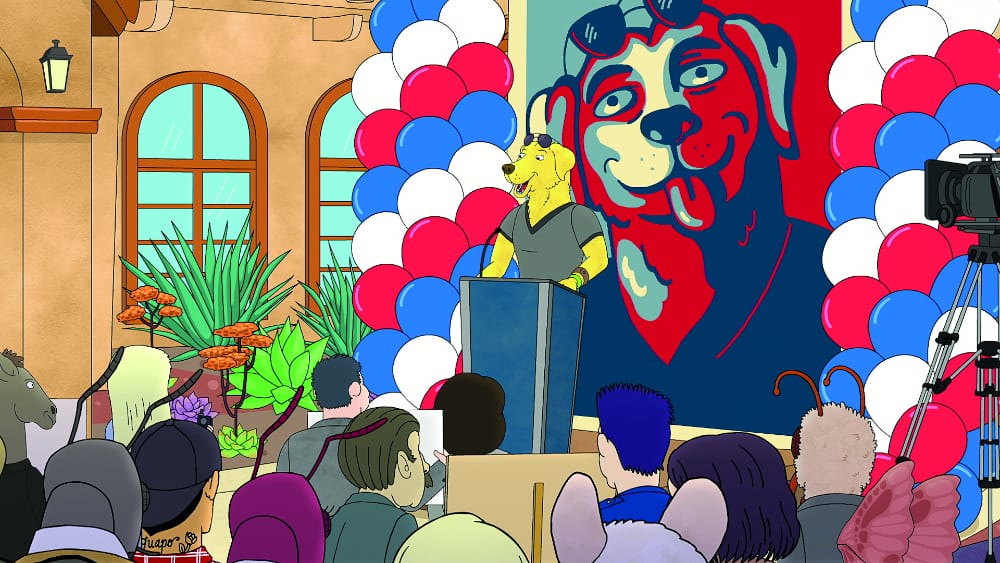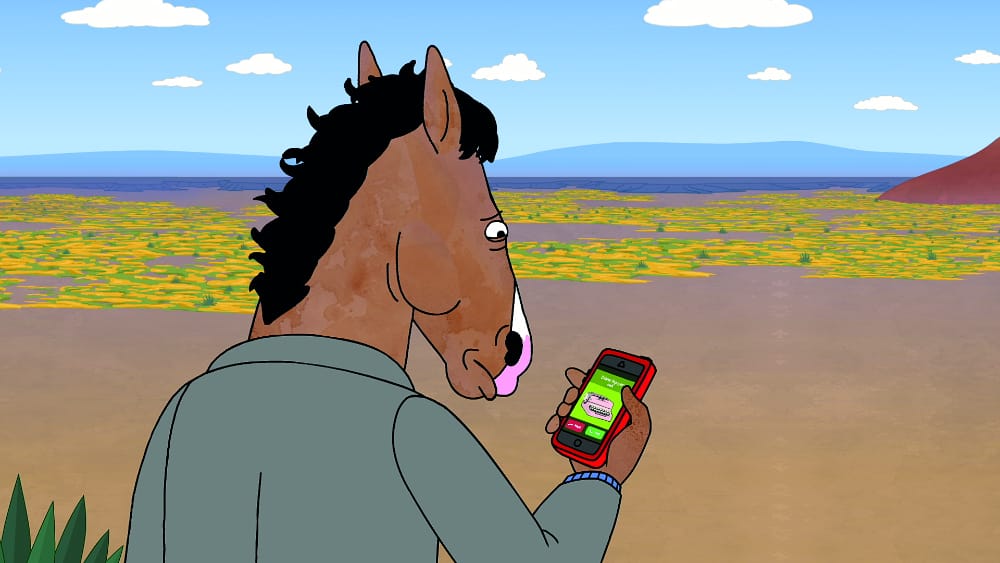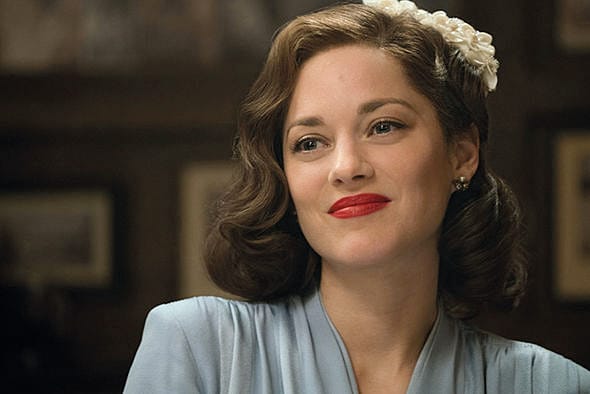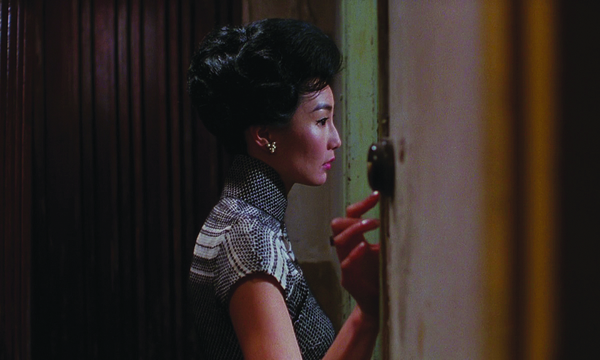The unbearable melancholy of Bojack Horseman
Season 4 is the show’s most difficult to date, but ends with a glimmer of hope.

The third season of Bojack Horseman ended with the question of whether our problematic protagonist would ever be able to move on. Following the death of his co-star and on-screen daughter Sarah Lynn during their drug binge, Bojack sets off in his car, driving far away from those he has let down. Ramming his foot down on the accelerator and taking his hands off the wheel, he drifts along the road, until he sees something that makes him slam on the break: a group of horses running through the open plains. They are able to do something that Bojack has been unable to – they are moving forward, into the future. Soundtracked by the haunting vocals of Nina Simone singing her heartbreaking ‘Stars’, it felt like a culmination of three seasons in which Bojack and his fellow Hollywoo characters had been circling around the same ideas of desperation.
Season 4 of Bojack Horseman sees the majority of the characters breaking new ground – Princess Carolyn is looking into the possibility of balancing her personal and professional lives, taking on a new boyfriend, as well as her new role as a manager (the incomprehensible difference between an agent and a manager is a running gag throughout the season); Todd is coming to terms with his asexuality, and learning to make peace with who he is; and Mr Peanutbutter and Diane are trying to work through the issues in their relationship amid a gubernatorial race – but for Bojack, this season will explore the root of his cyclical behaviour, reaching further back into the past than it has ever gone before.
“The take-home message is that trauma is often cyclical, and psychic scars generational”
For the last three seasons, we have only seen what Bojack’s formative years were like in passing, but over the course of these twelve episodes we get a much clearer look into the environment that formed him, and the reasons behind his personality. The take-home message: trauma is often cyclical, and psychological scars can be generational.

Following on from the first episode, marked by a distinctive lack of Bojack, we get him back in the next one. In “The Old Sugarman Place” he begins expunging the ghosts of his past, beginning with his toxic relationship with his mother; Beatrice Horseman (neé Sugarman) is an emotionally-manipulative bully, who traumatised Bojack both physically and mentally, but “The Old Sugarman Place” takes us back to her childhood, and things begin to become clear. A brother dying in the war sends her mother, Honey, into a spiral of grief, which is ‘cured’ by the stalwart of American mid-century psychiatry: a frontotemporal lobotomy, robbing Honey of any personality or vitality. “Love does things to a person, terrible things.” she advises, “Beatrice, promise me you’ll never love anyone as much as I loved Crackerjack.” It’s a hard episode to watch, and Bojack Horseman ’s creators double-down with the penultimate episode, “Time’s Arrow”, which lets us into Beatrice’s dementia-addled mind, filling in the gaps between her childhood and her motherhood. A Barnard-educated debutante who feels stifled under her father’s authority, she skips town with Bojack’s father, a lover of the Beats who is planning on writing ‘the great American novel’. Looking after Bojack crushes her younger self’s dreams, and – with her mother’s advice ringing in her head – it’s no surprise that she treats him so terribly.
“Aparna Nancherla does sterling voice-work as Hollyhock, bringing a vulnerability and likability to the role”
Whether this cycle can be broken is a question raised by the arrival into the show of Hollyhock, who believes Bojack is her illegitimate father. Aparna Nancherla does sterling voice-work as Hollyhock, bringing a vulnerability and likeability to the role, and she immediately fits into the Bojack universe. While Bojack has never shied away from conversations around mental health, this season develops the topic, looking at the heritability of mental illness: while Hollyhock would provide a meaning for Bojack’s life, she also serves as a reminder that he manages to taint everything he touches – above all his relationships with others.
This season is probably the most difficult season to watch of Bojack thus far, something that is aided and abetted by some of the experiments in style tried by the creators: in two episodes, we get a markedly different animation style as the writers let us into the minds of the characters. In “Stupid Piece of Shit” Bojack’s own negative thoughts are expressed as jagged scribbles, as we spend some time in his claustrophobic head, drawn down by cycles of negative thoughts and impulsive behaviours. Later on, in “Time’s Arrow”, Beatrice’s dementia is represented through rifts in reality, with backgrounds fading in and out, characters’ faces left blank or scrawled out, and words rearranging themselves.
The zany nature of the world of Hollywoo usually serves as a balm for some of the rawer aspects of Bojack, but this aspect is somewhat lacking in this season. West coast navel-gazing is explored through Mr Peanutbutter running for governor of California – a plot line that culminates in the episode “Underground”, which sees Jessica Biel (described as an “attempted movie star”) setting fire to Zach Braff after Mr Peanutbutter and Diane’s house falls into a sinkhole generated by fracking. These serve as welcome distractions from the main thrust of the season, although the attempts to shoehorn in political issues like gun control can seem a little pasted-on: when Diane sparks a debate about gun control in “Thoughts and Prayers” it isn’t given enough time to develop from the personal to the public.

Todd’s storyline develops little throughout the season, although since the main theme is self-acceptance, it is unsurprising that this is the case. His arc does manage to introduce another of his schemes in the latter half of the season: clown dentists, who provide enough material to generate running gags for a good six episodes.
Other than these aspects, the remaining characters experience an unremittingly bleak time of it. The cracks in Mr Peanutbutter and Diane’s relationship – both literal and metaphorical – begin to really show through, prompting the question of whether their differences compliment each other, or make them intrinsically incompatible. As usual, Alison Brie and Paul F. Tomkins deliver great voice work, with Brie in particular impressing this season. Her drink-induced breakdown comes around half way through the season, but time can’t heal all wounds, and we end with another argument, one that has Brie and Tomkins breaking through their characters’ façades – emotionally repressed for Diane, and glibly unaware for Mr Peanutbutter – to deliver emotionally-honest performances.
“‘Ruthie’ is one of the greatest episodes of Bojack thus far – a huge achievement”
None of the plot lines, however, can match Princess Carolyn’s, as she attempts to settle down with Ralph Cheeseman. Over the previous seasons of Bojack, we’ve come to know Princess Carolyn as a character defined by her strong work-ethic and can-do attitude; as she unleashed the revelation last season that she felt she had wasted her youth on Bojack, she comes into this season attempting to claw back some of what she feels she has missed. Things, naturally, don’t pan out, leading to one of the most emotionally-crippling episodes of the season: “Ruthie”, in which we are taken through one of the worst days in Princess Carolyn’s life. She begins the day pregnant, in a loving relationship, and in control of her business, but ends it with nothing – not even her precious family heirloom, or at least the idea behind it, is safe from the harsh realities of life. Even the framing device, which gave us some hope for Princess Carolyn’s future, is whipped away at the last minute, as the screen cuts to black. It’s not only one of the season stand-outs, but one of the best episodes of Bojack thus far – a huge achievement when you consider the strengths of some previous episodes.
Amy Sedaris is doing some of the best work of her career, and this season elevates her performance into one of the best currently on TV. Her performance in “Ruthie” is emotionally devastating, and she absolutely deserves an Emmy nod for it during awards season. She also manages to get her mouth around some serious tongue-twisters – example: “Portnoy finds joy in hoi polloi boy toy!” – of which there are a couple in each episode on average.
Her performance is complemented by a number of newcomers to the Bojack universe: Andre Braugher is magnificent as the incumbent governor Woodchuck Coodchuck-Berkowitz; Jane Krakowski, who has emerged as one of the stand-out stars of Unbreakable Kimmy Schmidt, is fantastic as Honey Sugarman; and Wendie Malick manages to take us through the entirety of Beatrice Sugarman’s adult development, from optimistic teenager to embittered mother, and through to cantankerous care-home resident, in one of the strongest performances of the season.
“Amy Sedaris is doing some of the best work of her career, and her performance is one of the best on current TV”
But while the season might be one of the bleakest seasons of Bojack yet, it also feels like the most confused: previous seasons managed to maintain a perfect balance between humour and tragedy, but there are certain episodes of season four that don’t really seem to work, particularly when they follow on from the gut-punches Bojack-creator Raphael Bob-Waksberg is so adept at delivering.
In some ways, this season was very much needed: all the major characters are left, if not in a better place emotionally, then in a more truthful position, setting things up for another strong season. Despite so much time spent examining his past, the character who seems to move on the most is Bojack himself. The season ends on a hopeful note – the most optimistic in the show’s history – suggesting that, maybe this time, the cycle can be broken, once and for all.
Bojack Horseman Season 4 is on Netflix.
4 Stars
Creator: Raphael Bob-Waksberg. Starring: Will Arnett, Amy Sedaris, Alison Brie, Paul F. Tompkins.









